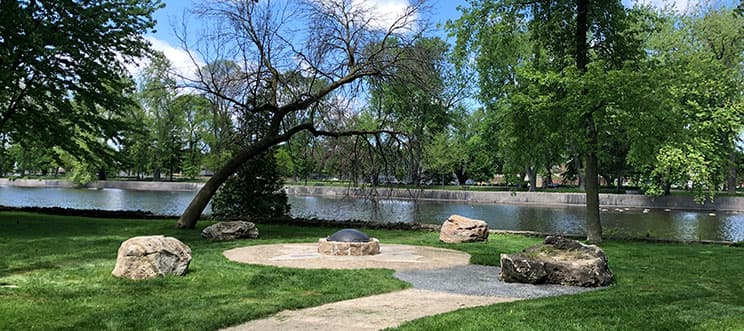On this page

Local First Nations, Métis, Mixed Ancestry, and Inuit have come together to create a Sacred Fire space located in Royal City Park.
This Sacred Fire was designed by representatives of the local First Nations, Métis, Inuit and Mixed Ancestry community to reflect the Original Peoples of the land on which we reside. The location was chosen for its proximity to the merging rivers, a meeting point for Original Peoples.
Indigenous groups use the Sacred Fire for spiritual gatherings including celebration, prayer, gratitude and personal healing. Fire Keepers support local Indigenous groups using the sacred fire according to their own unique traditions. Fire Keepers stay with the fire at all times.
The importance of gathering in circle for community, cultural and ceremonial purposes is shared across Indigenous Peoples of Turtle Island (North America).
This Sacred Fire is one of the ways the City of Guelph has chosen to honour the traditions of the many Original Peoples who live here today.
About the Sacred Fire
Sacred Fires hold profound significance in Indigenous cultures and are central to various ceremonies, healing rituals and seasonal celebrations. They reinforce traditional knowledge and nurture deep respect for the land and nature.
Sacred Fires serve as a gathering place, fostering a sense of belonging and community.
Please respect the traditions and practices of this important ceremonial site. Refrain from taking photos and keep pets away to help maintain the sanctity of the Sacred Fire and demonstrate respect for Indigenous cultures and communities.
First Nations, Inuit, and Métis people can reserve the Sacred Fire site by emailing [email protected] with the date and time of their event.
Reserving the site where possible will minimize interruptions and offer a more meaningful experience for all.
Territorial acknowledgement
As we gather, let us take time to reflect on our privilege to live and work in Guelph; a city built over rich Indigenous histories. We are guests here, and we should reflect upon the responsibility to care for this land, the people who live here today, and the generations to come. If our actions today can move us towards reconciliation, we should take pause and make those decisions with intention and gratitude.
This place we call Guelph has served as traditional lands and a place of refuge for many peoples over time, but more specifically the Attiwonderonk, and the Haudenosaunee. This land is held as the treaty lands and territory with the Mississaugas of the Credit First Nation. Guelph lies directly adjacent to the Haldimand Tract and is part of a long-established traditional hunting ground for the Six Nations of the Grand River. Many First Nations, Inuit, and Métis peoples who have come from across Turtle Island call Guelph home today.
Pronunciation guide
- Attiwonderonk (At-ti-wan-da·-ronk)
- Haudenosaunee (Ho-den-no-show-nee)
